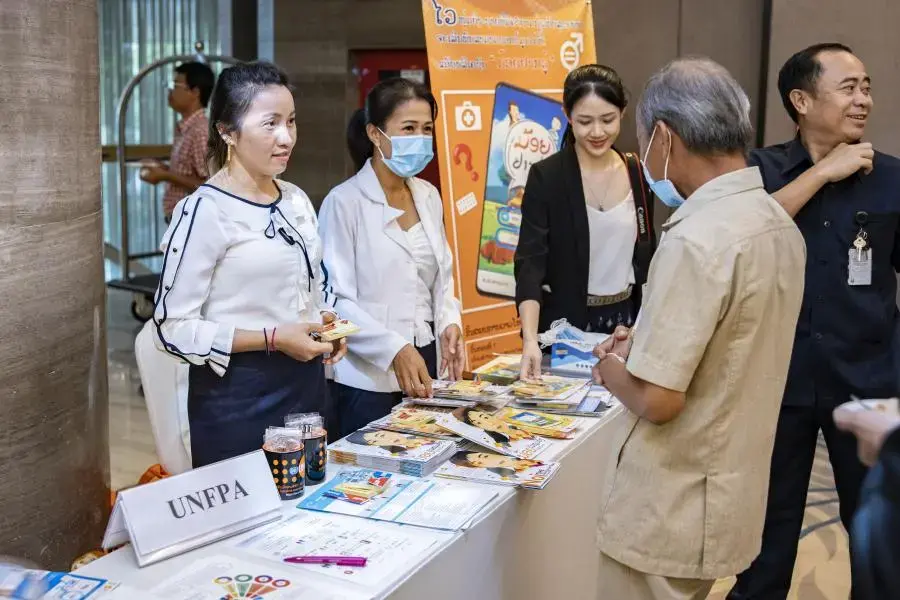The COVID-19 health crisis has affected all countries. Healthcare systems were not designed to deal with this unpredictable, large-scale health challenge, resulting in decreased access to health care, particularly for women and youth. In Lao PDR, as an example, compared to the first quarter of 2019, delivery at the health facilities dropped from 27911 to 25457 in the first three months of 2020. Key health workers were redeployed and assigned to help with the screening efforts for the large number of returning migrants to the country. Consequently, the number of outreach activities delivered to communities was reduced.
Adapting response quickly, UNFPA supported the Ministry of Health to redesign its Sexual, reproductive, maternal, newborn, child and adolescent health (SRMNCAH) services to minimise disruption.
Three solutions were proposed : i) strengthening safety of existing health facilities, task shifting and alternate service delivery modalities, ii) providing mobile services and iii) tele-health mechanisms for training and service provision.
Tele-health was strongly welcomed by providers and clients alike. Guidelines were adapted to the COVID-19 situation. They also included tele-health ones for Antenatal care, Postnatal care and Sick Child care. Using these , since October 2020, Ministry of Health and the Luang Prabang Provincial Health Department supported by UNFPA trained 38 health service providers from 3 district hospitals and 16 health centers.
Tele health enables health service providers to keep in contact with mothers, children and adolescents when face-to-face contact is challenging due COVID-19, or simply distance from or inability to reach the health facility or the village...
First, the tele-health training session gave an emphasis on active, respectful listening, how to ask meaningful questions in order to give the necessary advice. The training required a lot of efforts and practice to help service providers’ gain confidence. Along with the training sessions, health providers received a variety of capacity building tools such training videos, tools for keeping patient records and job aids to accomplish their job.
The Ministry of Health and UNFPA helped link facilities to communities through working with the village health committees and village health volunteers. The initiative used existing village mapping and community systems to identify pregnant women. Health providers were also equipped with the necessary technology such as internet card/mobile phone with useful health Apps uploaded. Through the virtual platform, the midwives and health professionals assist women in a timely manner but also have the opportunity to consult each other.
An example shared by midwife Lai. “One of my patients was suspected to have her postdate pregnancy and this case was seriously discussed through the virtual platform? We consulted with an obstetric expert at the central level. Then, a referral was quickly made for her afterwards to go into the facility to be induced”. “Another case was that just a few days after birth, a woman gave cooked rice feed to her baby instead of breastfeeding until 6 months. This was brought up and discussed through the chat group how to address this kind of traditional belief”.
The tele-health cast light on the fact that health education or advice must not be for women only but husbands as well, grand-parents and communities who may have more power to make decisions in families that could affect or save the life of mothers and newborns.
Already, 79 women have benefited from the tele-health services. This initiative is having a fruitful impact seen already in the early stages of implementation. It is very useful both for patients who get immediate assistance and for health care providers in terms of relevant knowledge and skill development to deliver quality services in order to reduce maternal and child mortality and morbidity. The approach will continue to be utilized as part of the routine health services especially during seasonal flooding that cause inaccessibility in several areas as well as to reach women in scattered and remote geographical conditions.
At the annual RMNCAH Review and Planning meeting on 24 December 2020, the Ministry of Health was supportive of the tele-health approach. This approach has already been put in the RMNCAH Plan of Action 2021 for other provinces namely Savannakhet, Boulikhamxai, Bokeo, Champasack and Oudomxai as part of Lao PDR commitment to ICPD25 to end maternal mortality by 2030.
The innovation was made possible due to the COVID-19 Multi-Partner Trust Fund. The technical standards used were based on the Operational guidance for South and Southeast Asia and Pacific regarding continuing essential SRMNCAH services during COVID-19 pandemic and the joint WHO/UNICEF/UNFPA guidance.
************
UNFPA, the UN's sexual and reproductive health agency, works in over 150 countries including Lao PDR, to achieve zero maternal deaths, zero unmet need for family planning and zero gender-based




